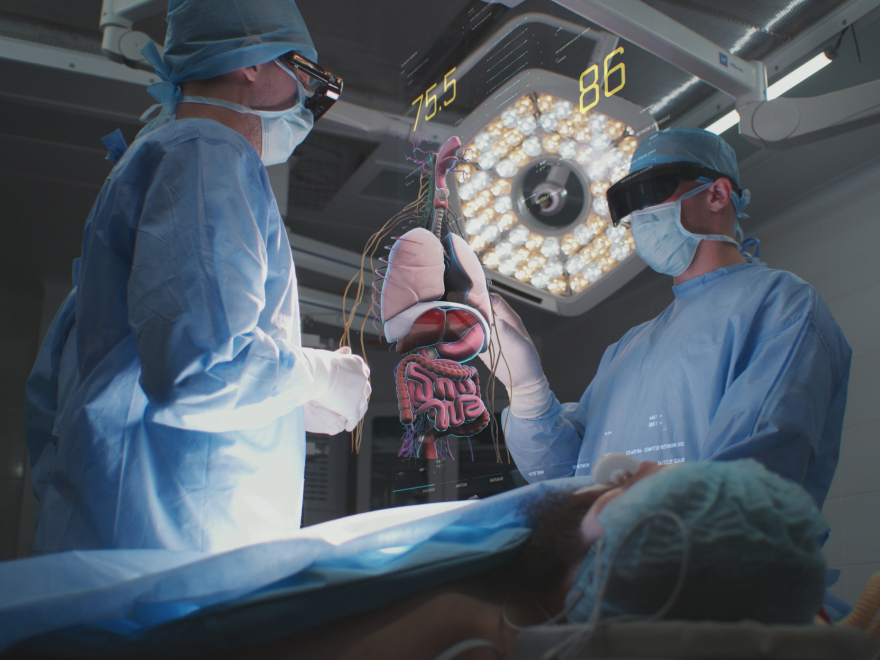Votre message a été envoyé.
Nous traiterons votre demande et vous contacterons dès que possible.
Le formulaire a été soumis avec succès.
Vous trouverez de plus amples informations dans votre boîte aux lettres.

Sélection de la langue

En clair, le secteur de la santé est très exigeant en matière de sûreté, de sécurité et de qualité des logiciels. C'est pourquoi des essais n'est pas seulement une meilleure pratique du secteur, mais aussi un must conformément à de nombreuses réglementations en matière de soins de santé, telles que les exigences de la FDA et du MDR, et aux normes informatiques, telles que les normes ISO 13485 et ISO 9001.
Certains peuvent être tentés de rogner sur l'assurance qualité pour réduire les dépenses du projet. Mais le jeu en vaut-il la chandelle ? Chez Innowise, nous sommes tous pour un test approfondi et réfléchi des applications de santéLe test de logiciels de soins de santé est un processus complexe, et je vais en faire l'analyse dans cet article. Restez avec nous et apprenez-en plus sur les types de tests de logiciels de santé, les processus et les résultats attendus.
De nombreux experts du secteur s'accordent à dire que les tests de logiciels dans le domaine des soins de santé ne doivent pas seulement être effectués, mais qu'ils doivent également l'être. doit être fait correctement. Voici ce qu'une approche attentive et méticuleuse des tests permet de réaliser.
Tester soigneusement tous les aspects des applications de soins de santé et résoudre les problèmes détectés conduit inévitablement à une meilleure qualité. Les tests sont essentiels pour détecter rapidement les bogues, éviter les corrections coûteuses après le déploiement et le mécontentement des utilisateurs.
Dans le domaine des soins de santé, les fournisseurs et les régulateurs se concentrent sur la sécurité des logiciels pour les utilisateurs finaux, en particulier lorsqu'il s'agit de SaMD et de SiMD. Garantir la sécurité des patients commence par des tests rigoureux pour détecter les problèmes susceptibles d'affecter la prise de décision clinique ou les soins aux patients.
Pendant les tests, négliger les exigences strictes de conformité de l'HIPAA, du GDPR ou de la FDA est une impasse. Lorsqu'elle est bien planifiée, l'approche des tests est adaptée pour identifier les lacunes en matière de conformité, préserver la confidentialité des données des patients et éviter des violations coûteuses ou des retards dans le lancement des logiciels.
Les données relatives aux patients étant l'un des types d'informations les plus sensibles, les tests constituent une autre mesure de protection. Les tests permettent de valider les méthodes de cryptage, de contrôle d'accès et de transfert de données, et d'identifier les vulnérabilités avant que des acteurs malveillants ne puissent les exploiter.
Lorsque certains aspects des soins aux patients reposent sur un logiciel, celui-ci doit fonctionner sans faille en cas de charge de travail importante. Une stratégie de test bien planifiée et exécutée permet de s'assurer que les applications de santé peuvent traiter de gros volumes de requêtes, maintenir une vitesse raisonnable et éviter les temps d'arrêt.
Si les tests sont effectués correctement, les prestataires de soins de santé peuvent être sûrs que les données traitées par le logiciel sont parfaitement exactes et traitées sans fragmentation ni perte. De cette manière, toute erreur de traitement des données est éliminée de manière proactive, sans jamais perturber les flux de travail des patients.
"La qualité des logiciels de santé ne peut jamais être compromise, et nous ne la prenons pas à la légère. Chez Innowise, nous veillons à ce que chaque ligne de code réponde aux normes les plus strictes. Avec nos certifications ISO 13485, ISO 9001 et ISO 27001, nous sommes non seulement des experts dans le développement de logiciels de haute qualité, mais aussi dans la détection précoce des bogues et la livraison de logiciels à la fois fiables et conformes."

Gestionnaire des livraisons
Il ne suffit pas de tester une application si l'on veut détecter les défauts et respecter le rythme et le budget du projet. Vous vous devez avoir une feuille de route claire sur la façon dont vous allez tester l'application sans retarder les déploiements ni compromettre la qualité.
En tant que membre de l'équipe d'Innowise, j'ai contribué à la réussite de nombreux projets dans le domaine de la santé. Laissez-moi vous dévoiler les secrets et partager avec vous le processus de test des applications de santé d'Innowise, qui s'avère efficace à chaque fois.
Innowise commence par se plonger dans votre tests de logiciels médicaux besoins. Notre équipe coopère avec les parties prenantes pour comprendre le champ d'application du logiciel, ses fonctionnalités, la documentation et les exigences réglementaires applicables. Cela permet de s'assurer que nous aligner la stratégie de test sur les objectifs du projetles seuils de sécurité, de sûreté et de conformité.
Ici, Innowise crée des cas de test détaillés sur la base des exigences et du plan de test. Nous concevons des scénarios qui couvrent les aspects fonctionnels et non fonctionnels de la solution de soins de santé, en nous assurant que nous testons tous les cas d'utilisation potentiels et que nous éliminons les problèmes éventuels.
Ensuite, nous préparons un environnement de test qui simule les conditions de production réelles. Il s'agit notamment de configurer le matériel, les logiciels et les paramètres réseau nécessaires. Notre équipe s'assure que l'environnement simule fidèlement les conditions du monde réel afin de détecter tout problème lié aux solutions de soins de santé avant leur déploiement.
Les AQ d'Innowise exécuter les cas de test, en documentant soigneusement les résultats. En fonction des spécificités et des contraintes du logiciel de santé, notre équipe utilise des méthodes manuelles et automatisées pour évaluer les fonctionnalités, les performances et la sécurité. Il est important de s'assurer que les problèmes sont identifiés et résolus dès le début du processus.
Nous vérifions les logiciels de soins de santé tout au long du processus de test, mais nous procédons à un audit final lorsque le logiciel est prêt à être lancé. L'audit consiste à examiner le logiciel et sa documentation pour valider le respect des exigences de l'HIPAA, du GDPR et de la FDA, ou d'autres réglementations. Notre équipe identifie toute lacune dans le traitement et la sécurité des données afin de garantir une conformité totale avec les normes.
Lorsque les tests sont terminés, nous fournissons des rapports détaillés mettant en évidence les défauts des logiciels, les incohérences et les points à améliorer. Notre équipe communique clairement les résultats et propose des correctifs afin que les développeurs puissent avoir une vision détaillée des changements nécessaires pour aller de l'avant.
En fonction de la manière dont le logiciel est évalué et de l'aspect évalué, les experts distinguent les types de tests suivants dans le domaine des soins de santé.
Les tests fonctionnels permettent de s'assurer que les principales fonctionnalités du logiciel de santé fonctionnent comme prévu. Ils comprennent des tests de compatibilité pour vérifier que le logiciel fonctionne sur différents appareils, navigateurs et systèmes d'exploitation. Les responsables de la qualité effectuent également des tests de régression pour vérifier que les nouvelles mises à jour n'altèrent pas les fonctionnalités existantes.
Conseil d'expert : La création de scénarios de tests fonctionnels détaillés peut sembler fastidieuse au premier abord, mais elle constitue la base du succès à long terme de votre logiciel. Des scénarios de test de haute qualité facilitent considérablement les mises à jour futures, rationalisant à la fois la maintenance et les mises à niveau du logiciel. Mieux encore, ils donnent confiance dans la couverture de vos tests et garantissent en fin de compte la qualité globale de votre application de santé.
Tests automatisés de logiciels dans le secteur de la santé est vital pour l'efficacité. Les ingénieurs AQ utilisent des scripts automatisés pour tester les tâches répétitives, telles que la saisie de données ou les interactions avec l'interface utilisateur, afin de réduire les erreurs et d'accélérer le processus. Ce type de test est particulièrement utile pour les solutions de soins de santé complexes et à grande échelle, comme les systèmes de gestion des dossiers ou les applications hospitalières complètes.
Conseil d'expert : Les applications de soins de santé sont devenues des écosystèmes sophistiqués avec une logique commerciale complexe, des bases de données étendues et des flux de données complexes provenant de plusieurs systèmes intégrés. L'automatisation des tests pour chaque aspect peut rapidement devenir prohibitive. Au lieu de cela, adoptez une approche stratégique en donnant la priorité à l'automatisation des flux de travail critiques pour votre entreprise, tout en gérant les fonctions moins cruciales au moyen de tests manuels.
Essentiels pour la sécurité des informations de santé protégées, les tests de sécurité identifient les vulnérabilités des logiciels de soins de santé afin d'empêcher les accès non autorisés ou les violations de données. Les testeurs de pénétration simulent des attaques potentielles pour vérifier dans quelle mesure la solution protège les données sensibles des patients et valide les mesures de protection de la vie privée en place.
Conseil d'expert : Selon Microsoft, les hôpitaux perdent en moyenne $1,9M par jour d'indisponibilité à la suite d'une attaque par ransomware. Ces chiffres font froid dans le dos, n'est-ce pas ? Cependant, ces pertes peuvent être évitées si vous donnez la priorité aux tests de sécurité et si vous faites appel à une équipe de test maîtrisant les meilleures pratiques de l'OWASP et de SOC 2, ainsi que les exigences des normes ISO 27001, ISO 27017 et ISO 27018.
Le succès des soins dépend souvent de leur rapidité, et les logiciels peu performants sont à proscrire dans ces scénarios. Les tests de performance permettent d'évaluer le fonctionnement du logiciel en cas de charge élevée, ainsi que son temps de réponse et sa stabilité. Ce type de test garantit que les solutions de soins de santé, en particulier celles qui suivent les données en temps réel, peuvent supporter des charges maximales sans que l'expérience de l'utilisateur n'en soit affectée.
Conseil d'expert : Dans le secteur de la santé, la rapidité est essentielle, et cette urgence s'étend aux performances de votre logiciel. Ne reléguez pas les tests de performance aux dernières étapes du développement. Au contraire, procédez à des évaluations approfondies des performances sur les premières versions de votre application de soins de santé. En étant proactif, vous identifierez rapidement les goulets d'étranglement potentiels et les traiterez au niveau de l'architecture lorsque les solutions sont encore relativement simples et rentables.
Les logiciels de soins de santé doivent communiquer avec d'autres systèmes informatiques, comme le DSE ou le DME, le CRM, le LIMS et d'autres. Les tests d'interopérabilité permettent de vérifier si l'application peut échanger des données opérationnelles et des données relatives aux soins avec des systèmes externes de manière transparente en utilisant les normes de données appropriées, telles que FHIR, HL7, DICOM et autres. Ce faisant, il permet d'obtenir un transfert de données précis entre les plateformes.
Conseil d'expert : Lorsque votre système de santé doit partager des données avec des solutions utilisant des normes d'échange différentes, l'intégrité des données lors de la transformation du format devient primordiale. Vous devez vérifier que les informations se transforment parfaitement entre les systèmes, sans perte ni corruption. Incluez dans votre plan de test une série complète de cas de test spécifiquement conçus pour valider la transformation des données.
Contrairement aux tests d'interopérabilité, ce type de test vise à vérifier l'intégration réelle de l'application et d'autres systèmes, et non sa capacité à échanger des informations. Les ingénieurs AQ vérifient que les données circulent correctement entre le logiciel et d'autres systèmes internes et applications tierces. Ce processus garantit que le logiciel de soins de santé fonctionne harmonieusement avec d'autres applications et fournit une vue complète des données en temps réel.
Conseil d'expert : Lorsque vous intégrez votre application de soins de santé à une solution informatique prête à l'emploi, il est tentant de ne pas effectuer de tests parce que "la plateforme dispose d'une API prête à l'emploi". Cette hypothèse peut s'avérer dangereuse. Même les API établies peuvent se comporter de manière inattendue dans des environnements uniques, compromettant potentiellement les données médicales critiques et les résultats pour les patients. Chez Innowise, nous ne laissons rien au hasard - nous testons rigoureusement chaque intégration pour nous assurer que les données circulent de manière transparente entre les systèmes.
Les applications de santé doivent répondre à des normes réglementaires strictes. Lors des tests de conformité, les équipes de projet vérifient que le logiciel est conforme aux exigences légales et de sécurité, telles que les directives HIPAA, GDPR ou FDA, et qu'il respecte les normes industrielles applicables.
Conseil d'expert : Si vous devez développer et tester un logiciel en tant que dispositif médical (une application qui nécessite une autorisation réglementaire conformément à la FDA et au MDR), il est indispensable de documenter toutes les activités du projet conformément à la norme ISO 13485 ou à la norme CEI 62304. Cette règle s'applique également aux tests. Veillez donc à choisir un partenaire de test possédant les certifications appropriées.
Les tests d'utilisabilité permettent de s'assurer que les patients, les médecins et les infirmières peuvent utiliser facilement le logiciel de soins de santé. Les ingénieurs AQ évaluent les interfaces et l'UX de l'application, confirmant qu'elles sont suffisamment intuitives. Les testeurs peuvent également valider l'accessibilité - vérifier si les utilisateurs souffrant de déficiences visuelles et motrices sont en mesure d'interagir avec l'application de soins de santé sans aide extérieure.
Conseil d'expert : Si les applications de santé sont souvent conçues pour favoriser l'accès aux soins, elles ne sont pas toutes faciles à utiliser pour les personnes ayant des besoins particuliers. C'est pourquoi nous encourageons nos ingénieurs d'assurance qualité à se mettre à la place des utilisateurs et à aller au-delà des exigences logicielles pour trouver des moyens de rendre le logiciel plus pratique pour, par exemple, les daltoniens ou les personnes dont la mobilité des doigts est limitée.
Lorsqu'un logiciel de santé est destiné à un public multilingue, les tests de localisation vérifient l'adaptation de l'interface du logiciel à plusieurs langues et le respect général des différences culturelles. Dans ce cas, les responsables de la qualité testent généralement les traductions, les formats de date et les préférences régionales afin de s'assurer que le logiciel est adapté à chaque utilisateur.
Conseil d'expert : Pour vous assurer que votre application de soins de santé est naturelle pour le public international, nous vous suggérons d'engager des analystes commerciaux ayant une expérience culturelle et linguistique pertinente au stade de la planification du logiciel. Plus tard, nous vous conseillons de choisir des contrôleurs de qualité compétents non seulement dans le domaine de la santé, mais aussi dans les langues cibles.
La gestion en interne des tests de logiciels de santé peut s'avérer une tâche fastidieuse. Vous devrez planifier le processus de test, recruter des ingénieurs d'assurance qualité possédant l'expérience requise, coordonner leurs tâches quotidiennes, synchroniser les tests avec le développement et veiller à ce que l'équipe atteigne les indicateurs de performance attendus. Cela semble bien compliqué, n'est-ce pas ?
Par ailleurs, pour faciliter les tests des applications de santé, vous pouvez externalisez l'ensemble du processus et épargnez-vous des maux de tête. D'après mon expérience, de nombreux clients d'Innowise dans le secteur de la santé se sont sentis beaucoup plus soulagés lorsqu'ils ont eu un accès quasi instantané à une équipe évolutive d'AQ possédant une expertise dans les technologies ou les solutions spécifiques dont ils avaient besoin. Voici les scénarios les plus courants dans lesquels notre équipe de test peut apporter son aide à un projet informatique dans le secteur de la santé.
Les services de test d'Innowise vont des tests fonctionnels aux tests de performance et de sécurité et peuvent répondre à vos besoins à la perfection. Nous appliquons des techniques manuelles et automatisées pour garantir une couverture optimale des tests et un budget équilibré pour le projet. Avec des années d'expérience dans le domaine de la santé et des tests, nos ingénieurs AQ sont des joueurs d'équipe : ils collaborent de manière proactive avec vos développeurs internes et ne négligent aucune piste.
Lorsque vous engagez Innowise en tant que Partenaire de conseil en informatique Pour vos projets de mise à jour et d'évolution des applications de santé, nous pouvons également faire appel à nos équipes de test. Elles évalueront la qualité du code, les obstacles à la performance de l'application, vérifieront les mesures de sécurité et détecteront les vulnérabilités. Ensuite, sur la base des résultats de l'assurance qualité, nos consultants possédant une expertise approfondie dans le domaine de la santé vont rédiger un plan en suggérant des améliorations et des changements.
Ingénieurs AQ en interne
années dans l'industrie
spécialistes de haut niveau et de niveau intermédiaire
Dans le secteur de la santé, les tests ne sont pas une simple formalité - c'est une étape essentielle pour garantir la sécurité, la conformité et la qualité des logiciels. Des vérifications fonctionnelles à la validation des performances, chaque test garantit que le logiciel fonctionne de manière fiable dans des environnements de soins de santé réels.
Si vous êtes à la recherche d'un produit fiable et de haute qualité tests de logiciels dans le domaine de la santé les services, n'hésitez pas à nous contacter. Nous sommes là pour vous aider à naviguer dans les complexités des tests de logiciels de santé et à vous assurer que votre application fonctionne comme vous l'attendez.

Partager:

Gestionnaire de portefeuille dans le domaine des soins de santé et des technologies médicales
Date : 23 avril 2025












Votre message a été envoyé.
Nous traiterons votre demande et vous contacterons dès que possible.

En vous inscrivant, vous acceptez notre Politique de confidentialitéy compris l'utilisation de cookies et le transfert de vos informations personnelles.